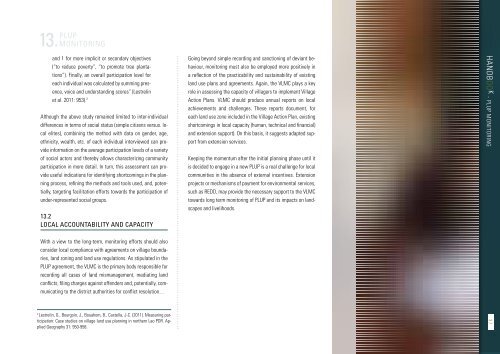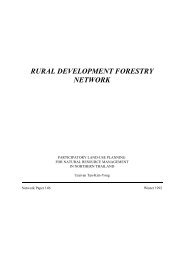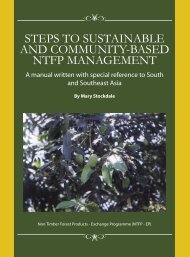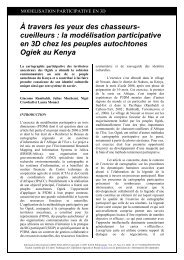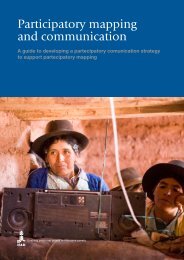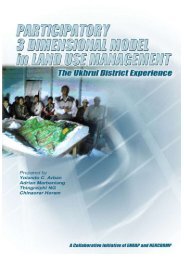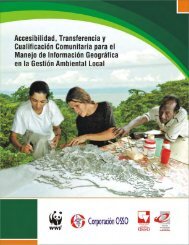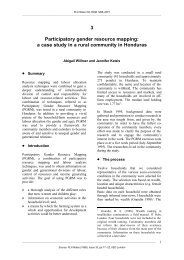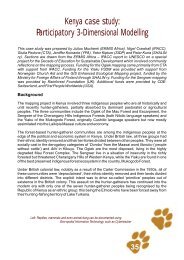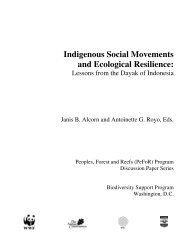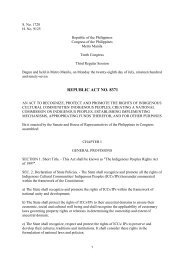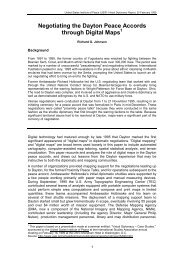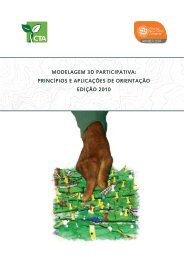Create successful ePaper yourself
Turn your PDF publications into a flip-book with our unique Google optimized e-Paper software.
13. PLUP<br />
Monitoring<br />
and 1 for more implicit or secondary objectives<br />
(“to reduce poverty”, “to promote tree plantations”).<br />
Finally, an overall participation level for<br />
each individual was calculated by summing presence,<br />
voice and understanding scores” (Lestrelin<br />
et al. 2011: 953). 2<br />
Although the above study remained limited to inter-individual<br />
differences in terms of social status (simple citizens versus. local<br />
elites), combining the method with data on gender, age,<br />
ethnicity, wealth, etc. of each individual interviewed can provide<br />
information on the average participation levels of a variety<br />
of social actors and thereby allows characterizing community<br />
participation in more detail. In turn, this assessment can provide<br />
useful indications for identifying shortcomings in the planning<br />
process, refining the methods and tools used, and, potentially,<br />
targeting facilitation efforts towards the participation of<br />
under-represented social groups.<br />
13.2<br />
Local accountability and capacity<br />
With a view to the long-term, monitoring efforts should also<br />
consider local compliance with agreements on village boundaries,<br />
land zoning and land use regulations. As stipulated in the<br />
PLUP agreement, the VLMC is the primary body responsible for<br />
recording all cases of land mismanagement, mediating land<br />
conflicts, filing charges against offenders and, potentially, communicating<br />
to the district authorities for conflict <strong>resolution</strong>…<br />
Going beyond simple recording and sanctioning of deviant behaviour,<br />
monitoring must also be employed more positively in<br />
a reflection of the practicability and sustainability of existing<br />
land use plans and agreements. Again, the VLMC plays a key<br />
role in assessing the capacity of villagers to implement Village<br />
Action Plans. VLMC should produce annual reports on local<br />
achievements and challenges. These reports document, for<br />
each land use zone included in the Village Action Plan, existing<br />
shortcomings in local capacity (human, technical and financial)<br />
and extension support). On this basis, it suggests adapted support<br />
from extension services.<br />
Keeping the momentum after the initial planning phase until it<br />
is decided to engage in a new PLUP is a real challenge for local<br />
communities in the absence of external incentives. Extension<br />
projects or mechanisms of payment for environmental services,<br />
such as REDD, may provide the necessary support to the VLMC<br />
towards long term monitoring of PLUP and its impacts on landscapes<br />
and livelihoods.<br />
HANDBOO K - PLUP Monitoring<br />
Participatory Land Use Planning (PLUP) HANDBOOK<br />
2<br />
Lestrelin, G., Bourgoin, J., Bouahom, B., Castella, J-C. (2011). Measuring participation:<br />
Case studies on village land use planning in northern Lao PDR. Applied<br />
Geography 31: 950-958.<br />
37


